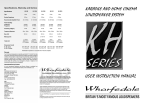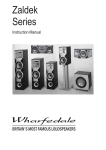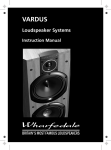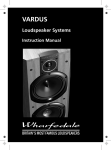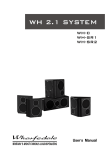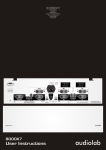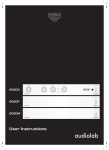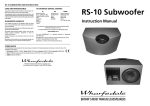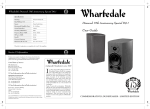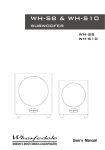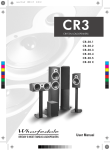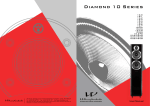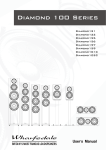Download Wharfedale RS-10 User's Manual
Transcript
RS-10 SPECIFICATIONS Bass/mid unit Tweeter Rec. Amplifier Nominal Impedance A/V shielding Sensitivity (1W @ 1M) Freq Range (-6dB) HF limit (-10db) Crossover Frequency Freq (Fb) Size (H x W x D) Height on shelf stand Height on floor stand Carton Quantity Included Accessories Optional Accessories RS-10 Satellite 100mm (4") kevlar cone x 2 25mm textile 20 - 120 w 6 Ohms* Yes 87db 85Hz - 24kHz 44Khz 2.8Khz 95Hz 600 mm x 127 mm x 95 mm 615 mm 1225 mm Pair 2 x wall brackets RS-10 Centre 100mm (4") kevlar cone x 2 25mm textile 20 - 120 w 6 Ohms* Yes 87db 85Hz - 24kHz 44Khz 2.8Khz 95Hz 127 mm x 600 mm x 95 mm 137 mm Home Cinema Loudspeaker System Instruction Manual Single 1 x wall bracket 1 x shelf stand Table Stands (pair pack) Floor Stands (pair pack) * Compatible with amplifiers requiring 8 Ohm loudspeakers. Wharfedale reserves the right to change specification without notice. *Table stands shown are optional extras Wharfedale International Ltd., IAG House, Sovereign Court, Ermine Business Park, Huntingdon, Cambs PE29 6XU, England. Tel:+44 (0)1480 447700 www.wharfedale.co.uk Wharfedale is a member of the International Audio Group. BRITAIN'S MOST FAMOUS LOUDSPEAKERS Delay Settings subwoofer. When you set the LFE level at your AV processor, use care as the powerful low frequencies can overload domestic loudspeakers. If you hear popping or thumping noises coming from the front loudspeakers or subwoofer, immediately turn the AV Processor's volume level down and then back off the LFE level. This should cure the problem. If it does not, back off the volume level at the subwoofer. Please read the relevant sections of your AV amplifier manual and familiarise yourself with the various issues. If you are unsure, consult your dealer for help. Many AV processors feature delay settings. The purpose of delay is to enable surround and dialogue information to arrive at the listener’s ears at the same time as the Front channels, even when the listening seat is in a non-ideal position. Rear Delay: If the listening position is equidistant from the Front and Rear speakers, a low delay setting should be set. The closer the listener is to the Rear speakers the higher should be the delay setting used, Phase A Home Theatre system should have a precise front stage, a diffuse rear stage and good localisation of dialogue. If the colours on the loudspeaker terminals do not correspond with those on the amplifier, the sound will appear poorly focused or ‘out of phase’. For this reason it is essential that the speakers are connected according to the wiring diagrams in this manual. Centre Delay: If the Centre speaker is level with (or slightly behind) the Front speakers, set the delay to zero. If the Centre speaker is forward of the Front speakers, increase the delay. LFE In domestic systems the LFE channel typically feeds into the PRELIMINARIES UNPACKING YOUR LOUDSPEAKERS After taking out the top-most packing piece, lift the loudspeakers and accessories from the carton and remove all the polythene bags. The contents of each carton are as follows: RS-10 Satellites: ! ! Two RS-10 satellite speakers Two wall brackets* RS-10 Centre: ! ! ! One RS-10 Centre speaker One wall bracket* One table stand with mounting hardware Check all the items after unpacking. If any item is missing or damaged, immediately contact your Wharfedale dealer. Retain the packaging. If you decide to dispose of the packing, follow all recycling regulations in your area. CARE AND SERVICE CARE Wharfedale will not be liable for any consequential damage, loss or injury, arising from or in conjunction with this equipment. The cabinets can be occasionally wiped with a damp (not wet) cloth. Spray polishes can be used but they must not be sprayed onto the grilles or drive units. Spray a very small amount of polish onto a cleaning cloth not the loudspeaker. The warranty on this product if it is sold outside the United Kingdom shall comply with applicable law and shall be the sole responsibility of the distributor that supplied this product. WARRANTY IN THE UK Service Addresses, UK & USA In the unlikely even that your unit develops a fault you should return it to your Wharfedale dealer using the original packing to ensure safe shipping. The terms of your warranty may vary in different countries but in all cases the guarantee excludes: IAG Service Centre Unit 4, St Margaret’s Way Stukeley Meadows Industrial Estate Huntingdon, Cambs, PE29 6EB England Tel:+44 (0)1480 452561 Fax: +44 (0)1480 13403 All damage caused through accident, misuse, wear and tear, neglect, incorrect installation, adjustment or repair by unauthorised personnel. Liability for damage or loss occurring in transit to or from the purchaser. IAG America, Inc. 15 Walpole Park South Walpole MA 02081 USA Tel: +1 508 850 3950 Fax +1 508 850 3905 * Note: No hardware is supplied to attach wall brackets to walls. Table stands and floor stands for the RS-10 satellites are available as optional extras from your dealer. Before installing this product read all these instructions! Before making any connections, switch the amplifier off. When you switch on your system or change sources, set the volume control at minimum and turn the level up gradually. DO NOT use your amplifier at full volume. Ensure that all loudspeakers in the system are correctly wired. DO NOT subject your loudspeakers to excessive cold, heat, humidity or sunlight. DO NOT place heavy objects on top of loudspeakers DO NOT connect loudspeakers to the mains supply. DO NOT dismantle the loudspeaker. There are no user serviceable parts inside it and you will void the warranty. PREPARATIONS FOR INSTALLATION Positive (+) terminal is on the left and has a Red collar. The Negative (–) terminal is on the right and has a Black collar. STANDS AND BRACKETS RS-10 loudspeakers must be operated attached to wall brackets or stands. Wall brackets are supplied for all RS-10 models and a table stand is also supplied for the RS-10 Centre speaker. To connect the terminals: Unscrew each terminal. Thread the bare end of the cable through the cross-hole in the terminal ensuring there are no loose strands. Tighten securely. Optional table stands and floor stands for RS-10 satellites are available in pairs from your Wharfedale dealer. b Use only the designed stands or brackets supplied with the units. c CONNECTORS AND CABLES You will need five lengths of two core cable. The cables connecting the Front loudspeakers should be the same length and the cables connecting the Rear loudspeakers should also be of equal length. We suggest you use cable designed for audio and not general purpose ‘bell’ or ‘zip’ wire. Loudspeaker cable is polarity coded along one edge. Split the cable to a depth of 25mm and strip 8mm of insulation from each wire. If the cable is stranded, twist the strands together. Before connecting your system consider where you will place the speakers in the room. This is particularly important if you are wall mounting loudspeakers. RS-10 loudspeakers have two connection terminals. The 6 1 STAND MOUNTING WALL MOUNTING CENTRE LOUDSPEAKER Amplifier Place the speaker on the stand and align the mounting holes in the stand with the mounting holes in the rear of the speaker. Place a shakeproof washer on each of the supplied screws and attach the stand to the speaker. Remove the speaker grille Thread the speaker cable through the recess at the edge of the cabinet and out through the hole in the rear of the stand. Prepare the cable and connect the loudspeaker as shown on Page 1. The striped or ribbed cable should be connected to the Red (+) terminal and the plain cable to the Black (-) terminal. Replace the grille. Place the speaker in position. Leave a little slack in the cable to avoid moving the stand assembly. FRONT LOUDSPEAKERS BRACKET POSITIONS - FRONT AND REAR SPEAKERS If the mounting position is higher than 1500mm it is preferable to angle the speaker. Otherwise mount the loudspeaker vertically. ANGLED VERTICAL REAR LOUDSPEAKERS If the loudspeakers are sited behind the listener on a rear wall, it is advisable to mount them high, around 1800mm and angled down. Rear speakers placed on the side walls may be placed at a height of 1500mm and angled vertically or 1800mm and angled down. Speaker Ensure that the wall is sound and can support the weight of the speaker. Mark off two centres 60mm apart and vertically spaced. Drill two 6mm holes and insert suitable wall plugs. Attach the bracket firmly to the wall with No 8 countersunk screws. Follow the drawings to establish the correct orientation of the bracket. 60 mm Locating Flange Locating Flange Bottom Tongue Bottom 60 mm Tongue CENTRE LOUDSPEAKER Align the bracket horizontally such that the loudspeaker is parallel to the wall. In all other respects the mounting procedure is identical. 60 mm *Note: Table Stands are not supplied with the RS-10 satellites but are available as optional extras SATELLITE SPEAKERS Thread the stand column through the stand base. Attach the column to the base with the four supplied screws. Thread the speaker cable through the slot in the column. Remove the grille from the loudspeaker. Remove the four mounting screws from the base of the speaker (circled in white in Fig.1). Retain the screws. Align the speaker over the column. Attach the speaker firmly to the column using the screws you have saved. Prepare the cable and connect the loudspeaker as shown on Page 1. The striped or ribbed cable should be connected to the left Red (+) terminal and the plain cable to the Black (-) terminal. Replace the grille. Lead the cable through the groove in the base of the stand and place the speaker in its location. Leave a little slack in the cable to avoid pulling the stand assembly over. Place the speaker on a soft surface. c Holding the speaker cabinet securely, c b ease the front grille off via the sides and keep it safe. b Identify the keyhole slot which is sited at the rear centre of the speaker. d The keyhole slot fits over the locating flange which is attached to the top of the bracket. Remove the four mounting screws from the base of the speaker (circled in white in Fig.3). Retain the screws. Thread the speaker cable through the bracket as shown. d Slot the speaker over the locating flange in the bracket and then slide it into the bottom tongue of the bracket Align the mounting holes in the bracket over the holes in the speaker and attach the speaker firmly to the bracket using the screws you have saved. Prepare the cable and connect the loudspeaker as shown on Page 1. The striped or ribbed cable should be connected to the left Red (+) terminal and the plain cable to the Black (-) terminal. Replace the grille. 4 To AV Amplifier 3 CONNECTING THE LOUDSPEAKERS HOME THEATRE LAYOUT POSITIONING THE FRONT SPEAKERS RS-10 speakers must be wall or stand mounted. Their bass extension depends on proximity to a wall, though they should be kept out of room corners. Ideally they should be mounted 1-2 metres above the floor and 2-4 metres apart, central to the listening position. 2 - 4 metres >0.7metre Listening Seat 2-4metres away POSITIONING THE REAR SPEAKERS The speakers should ideally be sited 600 mm-1.5 metres above the listening position and 2.5-3.5 metres apart, central to the listener and either on a rear wall or on either side of the listener facing inward, but always behind the listening position. LISTENING POSITION POSITIONING THE CENTRE SPEAKER The RS-10 Centre speaker is clearly identified with the badge horizontal to the speaker. so make sure you don’t use it as a satellite by mistake! The speaker should be on its dedicated stand, located TV on a stable, flat surface to avoid any movement of the loudspeaker at high sound levels. Alternatively it can be wall mounted. We recommend that the RS-10 Centre is mounted DVD above the TV screen, with the front grille level or slightly in front of the screen. It may also be placed below the screen. The television should be positioned centrally between the front loudspeakers and the front face of the RS-10 Centre should ideally be in line with the front loudspeakers. 2.5 - 3.5 metres HOME THEATRE LAYOUT Connect each loudspeaker to the correct channel of your AV amplifier or processor taking care to connect the Red, Positive (+) terminal of the speaker to the Red, Positive (+) terminal of the speaker output terminal of the amplifier, and similarly with the Black (–) terminal. CENTRE INPUT OUTPUT LEFT RIGHT LINE LEVEL A/V PROCESSOR SUBWOOFER SUBWOOFER OUT FRONT L L C FRONT R R RIGHT LEFT REAR REAR SETTING UP YOUR HOME CINEMA THE 5.1 HOME ENVIRONMENT The preferred 5.1 positions are shown in the drawings below. If you have a large room or your listening position is not central to the side walls (as in the diagram), we recommend that you purchase the optional table or floor stands which have been designed to optimise the soundstage of the RS-10 system. Placing rear speakers on opposite side walls (shown in pale grey in the figure on the left) is acceptable in smaller rooms but is not recommended for large rooms. The front loudspeakers are placed on either side of the television screen, 2 to 3 metres apart. If you are using the optional stands, the speakers may be angled slightly inwards so they are aimed towards the listeners. The performance of Home Theatre systems can be enhanced by using a pair of subwoofers. Setting Loudspeaker Sizes Many digital AV Processors require you to specify the size of speakers in all channels. These are usually ‘Large’ or ‘Small’. All the channels should be set to SMALL . This routes all the bass to the subwoofer. As the rear surround channels are the ‘effects’ channels the sound should be as room filling as possible. We recommend placing the speakers in a high position, behind the listener’s head. Most of the dialogue comes from the centre loudspeaker. Speech should appear to originate from the actors’ mouths. Operating height is important. Ideally the front and centre channel speakers should be at the same height .The front faces of the centre and surround loudspeakers should also be in line as far as possible. Setting Levels Once the loudspeaker settings have been finalised, put the AV amplifier into its “Test” mode (see instructions supplied with your processor). Adjust the level of each channel in turn until all channels are reproduced at equal loudness. The system is intended for use with the RS-10 subwoofer. This should be placed 50mm from the wall to optimise the bass performance of the unit. (See P 3 of the subwoofer manual.) On some programmes the surround channel may seem lower than the front. Do not readjust this level. You may, however, need to adjust the subwoofer output level. Do not set too high a level or you will swamp the sound with bass. You should also set a sensible level going into the subwoofer from the AV processor. Set the RS-10 subwoofer LPF filter to 85 Hz. Follow pages 5 & 6 of the subwoofer manual for the correct setup procedure. 2 5





